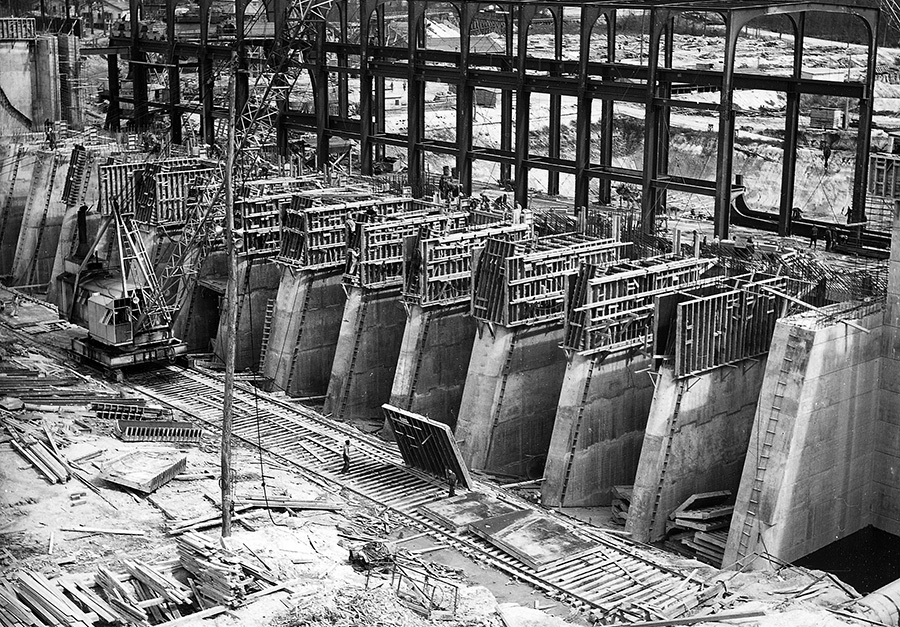
It was the 1930s, and the United States was facing one of its most difficult eras. The Great Depression and the Dust Bowl had dealt a bad hand to the majority of Americans, with widespread unemployment, poverty and financial instability. As families gathered around their radios, they longed for something positive to dance across the waves.
At the time, several major infrastructure projects were underway, part of President Franklin D. Roosevelt’s New Deal. The Southwest saw the completion of the Hoover Dam, and parts of Appalachia were given similar hope with the formation of the Tennessee Valley Authority. But a substantial number of areas in South Carolina lacked electricity and the opportunities and modern conveniences that much of the country was beginning to enjoy. And that’s where Santee Cooper’s story begins.
Santee Cooper was born from the New Deal on April 7, 1934, offering a glimmer of hope to the state by laying the groundwork to create better lives for all South Carolinians. The project did this by addressing the need for rural electrification and water resources. In the following years, the state saw a flurry of activity as Santee Cooper’s infrastructure took shape.
With the completion of the Pinopolis Dam came the formation of Lakes Marion and Lake Moultrie, which are among the largest lakes in South Carolina. Known as the Santee Cooper Lakes System, these beautiful bodies of water cover an astounding 160,000 acres. Because of the region’s proclivity to flooding during heavy rainfall and hurricanes, the lakes and dam system also provided control of the flooding impact of these natural phenomena.
The lakes provided the power necessary for Santee Cooper to generate its first spark of electricity in 1942. The water flow from these monstrous lakes pushed its way from the penstock to the turbine, creating the energy needed to generate the much-needed electricity that was sent through transmission and distribution lines to homes, businesses and industries. To date, the Jefferies Hydroelectric Station still produces this renewable and environmentally friendly source of power.
In 1954, Jefferies Generating Station introduced oil-fired electricity to Santee Cooper, and in 1966 our Grainger Station began sending coal-fired generation to the area. This opened the door for other generating stations to be brought online including the construction of Winyah Station in 1975 and Cross in 1983 resulting in much more generating capacity over the years.
Creating the two largest bodies of water in the state meant more than keeping electricity flowing. It also led to a valuable water resource for rural communities. In 1994, the Regional Water System was formed, and Santee Cooper invested in developing and maintaining a vast infrastructure that included water treatment plants, storage tanks, pipelines and pumping stations. Today, the Regional Water System serves a population of more than 227,000 people. The Lake Marion Regional Water System followed in 2008 and serves more than 3,300 people in rural South Carolina.
The Santee Cooper Lakes provide even more than power and water. With so many acres of natural beauty, it stands to reason that the lakes constitute one of the most impressive recreational destinations in the state. From kayaking to camping, it’s a nature lover’s dream come true. It’s also a great place for biking and birding, with miles of trails and hundreds of species of birds. But perhaps its main draw is world-class fishing.
The lakes are a reminder of how Santee Cooper was born from the natural environment of South Carolina, and Santee Cooper hasn’t forgotten the importance of keeping that environment thriving. The balance between generating and distributing reliable power and water and protecting the ecosystem can be challenging, but the harmony between them is a beautiful element to a song worth composing.
As the world evolved with the understanding of the impact that fossil fuels have on the environment, along with it came stricter regulations to ensure existing plants were operating as cleanly as possible. Santee Cooper took measures to comply with each legislative decision. When the time came to decommission the Grainger Generating Station in Conway, Santee Cooper took the opportunity to return that area to its former natural glory as a wetlands area.
A little farther south in Berkeley County, a similar type of reclamation took shape when Santee Cooper began developing the nearly 7,000 acres of the Camp Hall Commerce Park, home to more than 30 bird species and other wildlife. Santee Cooper dedicated more than 2,600 acres to fostering wildlife habitats and improving local ecosystems. This earned Santee Cooper and Camp Hall the South Carolina Community Star Award for exceeding environmental requirements.
Camp Hall is the commerce park of the future, fostering greater connections between the workforce and the natural surroundings. Not only is the park a testament to Santee Cooper’s focus on the environment, but it’s also a shining example of our dedication to economic growth. Our efforts helped bring billions of dollars in new capital investment and the promise of thousands of jobs every year, making Santee Cooper an important driver of growth in South Carolina.
Santee Cooper isn’t just part of South Carolina – it is South Carolina. We’ve been generating much more than power for more than 90 years and are woven into the very fabric of this great state. We work here, live here, and dedicate ourselves to making our home the best it can be.